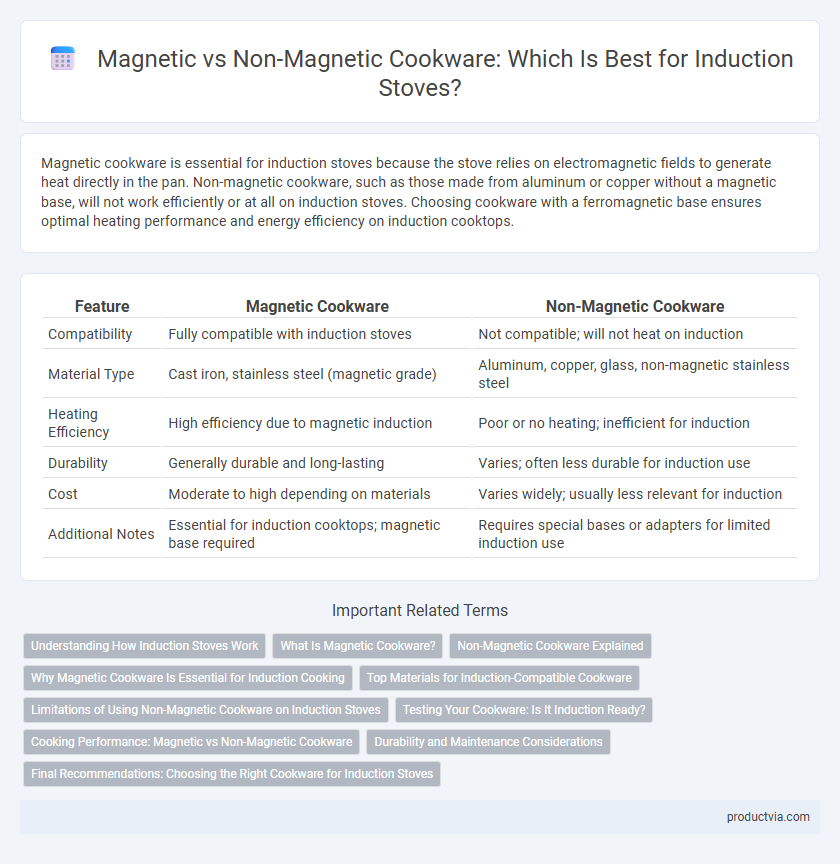Magnetic cookware is essential for induction stoves because the stove relies on electromagnetic fields to generate heat directly in the pan. Non-magnetic cookware, such as those made from aluminum or copper without a magnetic base, will not work efficiently or at all on induction stoves. Choosing cookware with a ferromagnetic base ensures optimal heating performance and energy efficiency on induction cooktops.
Table of Comparison
| Feature | Magnetic Cookware | Non-Magnetic Cookware |
|---|---|---|
| Compatibility | Fully compatible with induction stoves | Not compatible; will not heat on induction |
| Material Type | Cast iron, stainless steel (magnetic grade) | Aluminum, copper, glass, non-magnetic stainless steel |
| Heating Efficiency | High efficiency due to magnetic induction | Poor or no heating; inefficient for induction |
| Durability | Generally durable and long-lasting | Varies; often less durable for induction use |
| Cost | Moderate to high depending on materials | Varies widely; usually less relevant for induction |
| Additional Notes | Essential for induction cooktops; magnetic base required | Requires special bases or adapters for limited induction use |
Understanding How Induction Stoves Work
Induction stoves generate heat through electromagnetic fields that induce currents in magnetic cookware, making only ferromagnetic materials like cast iron and certain stainless steels compatible. Non-magnetic cookware, such as aluminum, copper, and glass, cannot complete the electromagnetic circuit and therefore do not heat up on induction surfaces. Understanding this principle helps users select appropriate cookware to maximize the efficiency and safety of induction cooking.
What Is Magnetic Cookware?
Magnetic cookware consists of materials like cast iron or certain stainless steels that contain ferromagnetic properties necessary for induction stoves to generate heat through electromagnetic fields. Unlike non-magnetic cookware such as aluminum or copper, which do not interact with induction cooktops, magnetic cookware enables efficient energy transfer and rapid heating. The compatibility of magnetic cookware is essential for proper functionality and optimal performance on induction stoves.
Non-Magnetic Cookware Explained
Non-magnetic cookware does not work with induction stoves because induction technology relies on electromagnetic fields to generate heat directly in the pan. Materials like aluminum, copper, glass, and some stainless steels lack the ferromagnetic properties needed to interact with the stove's magnetic coil. Without this interaction, non-magnetic cookware remains cool, making it incompatible for efficient cooking on induction surfaces.
Why Magnetic Cookware Is Essential for Induction Cooking
Magnetic cookware is essential for induction stoves because induction technology relies on electromagnetic fields to generate heat directly within the pot or pan, which only occurs with ferromagnetic materials such as cast iron or certain stainless steels. Non-magnetic cookware, like aluminum, copper, or glass, cannot interact with the induction cooktop's magnetic field, resulting in no heat production and ineffective cooking performance. Using magnetic cookware ensures optimal energy transfer, faster heating times, and consistent cooking results on induction stoves.
Top Materials for Induction-Compatible Cookware
Induction stoves require cookware made from magnetic materials such as cast iron, stainless steel with a magnetic base, and carbon steel to ensure efficient heat transfer. Non-magnetic materials like aluminum, copper, and glass are incompatible unless they have a magnetic layer bonded to the base. The top materials for induction-compatible cookware include enameled cast iron, magnetic stainless steel, and seasoned carbon steel, which provide optimal performance and durability on induction cooktops.
Limitations of Using Non-Magnetic Cookware on Induction Stoves
Non-magnetic cookware, such as aluminum, copper, or glass, is incompatible with induction stoves because it lacks the ferromagnetic properties necessary for electromagnetic induction heating. This limitation results in no heat generation or extremely inefficient cooking performance when using non-magnetic pots and pans on induction surfaces. Induction technology requires cookware with a magnetic base, typically stainless steel or cast iron, to create the electromagnetic field that generates heat directly in the vessel.
Testing Your Cookware: Is It Induction Ready?
Testing your cookware for induction readiness involves checking if the base is magnetic since induction stoves require magnetic materials like cast iron or stainless steel with a magnetic grade. You can perform a simple magnet test by placing a magnet on the bottom of the pot or pan; if it sticks firmly, the cookware is compatible with induction cooking. Non-magnetic materials such as aluminum, copper, or glass will not work on induction stoves unless they have a magnetic layer added to the base.
Cooking Performance: Magnetic vs Non-Magnetic Cookware
Magnetic cookware, typically made from ferrous metals like cast iron or stainless steel with a magnetic base, ensures efficient heat transfer and consistent cooking performance on induction stoves due to its direct interaction with the electromagnetic field. Non-magnetic cookware, such as aluminum or copper without a magnetic layer, fails to generate the necessary heat on induction cooktops, resulting in poor or no cooking performance. For optimal results and energy efficiency, selecting magnetic cookware is essential to fully leverage the rapid heating capabilities of induction stoves.
Durability and Maintenance Considerations
Magnetic cookware, specifically those made from cast iron or stainless steel with ferromagnetic properties, offers superior durability for induction stoves due to their ability to withstand high heat without warping or degrading. Non-magnetic cookware, such as aluminum or copper, generally requires a magnetic base layer to function on induction stoves, which may affect long-term performance and maintenance needs. Maintenance for magnetic cookware is typically easier, as it resists scratches and is often dishwasher safe, while non-magnetic cookware with induction-compatible coatings may demand more careful handling to preserve the magnetic layer's integrity.
Final Recommendations: Choosing the Right Cookware for Induction Stoves
Magnetic cookware is essential for induction stoves because its ferromagnetic properties enable efficient heat transfer through electromagnetic induction, ensuring rapid and even cooking. Non-magnetic cookware, such as aluminum or copper without a magnetic base, is incompatible and will not heat on induction surfaces. For optimal performance and energy efficiency, select cookware made from cast iron or stainless steel with a magnetic base specifically designed for induction cooking.
Magnetic cookware vs non-magnetic cookware for induction stove Infographic

 productvia.com
productvia.com